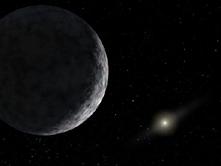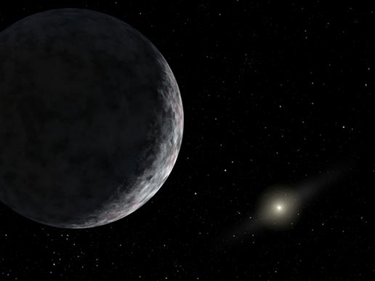Celestial Update
Air Date: Week of September 23, 2005

This artist's image shows the object catalogued as 2003UB313 at the lonely outer fringes of our solar system. Our Sun can be seen in the distance. The "planet" was discovered by the Samuel Oschin Telescope at the Palomar Observatory near San Diego, Calif., on Jan. 8, 2005. (NASA/JPL-Caltech)
Scientists are talking about a newly discovered object that’s larger than Pluto. Astrophysicist and New York Hayden Planetarium Director Neil deGrasse Tyson talks with host Bruce Gellerman about this so-called "tenth planet" and about an asteroid that may be heading towards Earth. Look out!!!
Transcript
GELLERMAN: It’s Living on Earth, I’m Bruce Gellerman, sitting in for Steve Curwood. Astronomers have some good news, and possibly some bad news. The good news? They might have discovered a new planet. The bad news? We might need it.
Joining us is astrophysicist Neil deGrasse Tyson, head of the Hayden Planetarium in New York City and a frequent contributor to our program. Welcome back to Living on Earth, Dr. Tyson.
TYSON: Great to be back with you.
GELLERMAN: So, how exciting, they might have discovered a new planet in our solar system? The first since Pluto in 1930?
TYSON: Well, we’ve been discovering things in the outer solar system for quite some time now, or at least since the early 1990s, and so every time a new one of these objects is discovered, the media sort of jumps on it and says, “oh, another planet! Another planet!”
And then we look and see, well, it’s kind of small, and mostly ice, and should it be a planet? And then that brings up the concern about what the definition of a planet is, and is Pluto really a planet? And so it goes on and on and on and on and on.
What makes this recent discovery rise above the rest is that this object is bigger than Pluto. So, whatever rules you invoke for Pluto, they would surely then have to apply to this object. So that’s what made it exciting. GELLERMAN: So, do you think it really is a planet? TYSON: Well, as you may know, in the Rose Center for Earth and Space here in New York which contains the rebuilt Hayden Planetarium, we opened in 2000, and our exhibits did not count Pluto among the rest of the planets in the solar system. Rather than count planets, which I personally think is a pointless exercise – there’s no science in how many planets there are orbiting a sun – what you want to do is group them by like properties. Then there’s some knowledge to be gleaned from that. You can even teach that in elementary school. So, rather than count and enumerate the planets, we grouped, for example, the small rocky objects in the inner solar system – Mercury, Venus, Earth, Mars – we grouped them together. And those are the terrestrial planets. The word is still a convenience, but you know they’re all small, rocky and dense. Then there’s the big, giant, gaseous, low-density Jupiter, Saturn, Uranus and Neptune. They fit together as a family. There’s the asteroid belt that separates the two. And in each of these families, the objects within them look more like each other than any one of them look like the other families. So now you have Pluto, which doesn’t match anything else in the solar system except for other objects we’ve recently discovered orbiting the sun with it. These are objects that are mostly ice by volume which, if they came close enough to the sun, they’d grow a tail. Well, we have words for icy objects that grow tails: they’re comets. And so we have relegated Pluto and its icy brethren to this new swath of real estate, recently discovered, which is the swarm of comets orbiting beyond Neptune. GELLERMAN: Well, what does this object look like? TYSON: Well, it’s not clear, orbiting very far away but still within the zone that we’ve identified as the zone of comets. By the way, there was an astronomer at mid-last century who theorized there might be this reservoir of comets beyond Neptune, and his name was Gerard Kuiper, so we call it the Kuiper Belt of Comets. So, Pluto and this new object each orbit within the Kuiper Belt of Comets. We know that it is at least bigger than Pluto; could be much, much bigger than Pluto, it’s not yet known. Its surface is surely almost 100 percent ice, and the rest of its volume is likely to be like the rest of what you find in the Kuiper Belt: mostly ice. GELLERMAN: Now, this thing has got the unmemorable name of 2003UB313, am I right? TYSON: Yeah, that’s its phone number, we like to call it (laughs). GELLERMAN: Not a very catchy name though. TYSON: Yeah, and we don’t use – I mean, that’s the catalogue name, but even between friends and astronomers, we’re ready to get the thing named according to the way other objects in the solar system are named, and we will surely use that new name thenceforth. But that takes a little while. We have to entertain suggestions. The discoverer wanted to name it “Xena,” the famous warrior princess of television fame. GELLERMAN: Huh. TYSON: I kind of like that name. It has that kind of Greek sound to it, even though it’s just a made-up name. It’s not likely that will get through the judges, but we’ll see. GELLERMAN: Well, if there is a new planet, Dr. Tyson, it might come in very handy in the near future. I hear that astronomers have identified an asteroid that’s heading our way? TYSON: Yes, an asteroid was discovered mid-last year, and it has the uninteresting name 2004MN4. And it went unremarked upon on because many asteroids are discovered each year that never reach public notice. Except that when it went behind the sun, going out of view from the sun’s glare, and then was rediscovered in December, we were able to calculate its orbit and determine that it’s trajectory was going to intersect Earth in the year 2029 or the year 2036. This didn’t make it to the front of the newspaper because around that same time, you might remember, there was a tsunami in Indonesia – which, of course, rightly so, got the better part of all the headlines. But, ironically, this object, if it hits Earth, would create a tsunami dwarfing the one reported on in December ’04. GELLERMAN: What are the chances of this asteroid hitting Earth? TYSON: Well, rather than give you probabilities, because what you really need to know is what’s going on. We know where the object is headed, and we know how fast it’s moving, and we have a sense of the forces of gravity in the solar system. The problem is the uncertainty in that trajectory normally is not a problem; if it misses Earth by a million miles, or a million and a thousand miles, who cares? But, in this case, in the year 2029, the calculations show that this asteroid will come within the orbits of even our communication satellites. GELLERMAN: Ooh, that’s close. TYSON: That’s close. That’s close. This will be the largest object ever known to come within our communication satellites in the era of space exploration. And so, turns out, what we know of the orbit right now, we can say it will not hit Earth in 2029 but it might hit Earth in 2036. It will hit Earth in 2036 if it passes through what we call a “keyhole,” which is a range of positions close to Earth where the gravity of the Earth will realign its trajectory ensuring that seven years later it will hit Earth. And so what we need to do is deflect it in such a way that it misses that keyhole. GELLERMAN: So, this keyhole’s kind of like a place in space, a doorway? TYSON: Exactly! It’s like a car door through space where the gravity of Earth operating on that asteroid in that corridor will pull on that asteroid in 2029 in such a way that in 2036 it will hit Earth. So, you want to deflect the asteroid so that it misses that keyhole. GELLERMAN: So, if it did hit Earth, do we know where it might hit? TYSON: If the asteroid in 2029 passes anywhere in the keyhole we know where it will end up hitting Earth in 2036. It’ll hit somewhere between Hawaii and California in, obviously, the Pacific Ocean. That hit will generate tsunamis on the level that has never been experienced in recorded history. But the advantage is you would know in advance so that, while you might lose $400 billion worth of property, no one actually has to die from this tragedy the way people died in Indonesia. There was no warning for that tsunami. This one you can have decades of warning if, in fact, we can’t do anything about it. GELLERMAN: So, it sounds like we should be planning for this right now. TYSON: Right now, there’s legislation in front of Congress to try to vote sensibly about directing monies for study. What would be the best way to deflect it? Do you shoot laser beams at it? Do you attach retrorockets to it? There’s some leading ideas but there are many other ideas in the bin that are being considered. So, Congress has taken the first step. GELLERMAN: So, Dr. Tyson, do you stay awake at night worrying about the demise of Earth from asteroids? TYSON: Yeah, well, this asteroid is deflectable. It’s about, you know, 200 meters across, about the size of the Rose Bowl, and, so this one, yeah, I know they’re out there, and it’s a shooting gallery. The ones I really worry about, however, are the kind that’s the size that took out the dinosaurs. Those things are the size of Mt. Everest. That can happen again. It will happen again. And, in that case, if anyone survived you’d have to jumpstart civilization. That’s what I worry about. This is one of the calls for being a multi-planet species – one planet gets taken out, you at least have another one left. Or find really effective ways of deflecting these things. GELLERMAN: You’re making planet Xena sound better and better all the time. TYSON: (Laughs) Yeah. Planet Xena will be cold and dark, but Mars looks pretty good, actually. GELLERMAN: Dr. Neil deGrasse Tyson is director of the Hayden Planetarium and co-author, with Donald Goldsmith, of the book “Origins: Fourteen Billion Years of Cosmic Evolution.” Dr. Tyson, it’s always good talking with you. Thank you. TYSON: Thanks for having me on. Links
|






